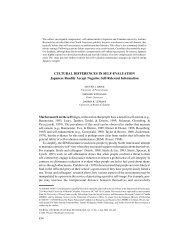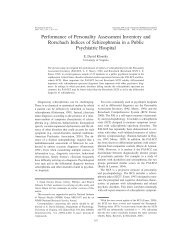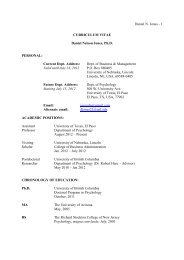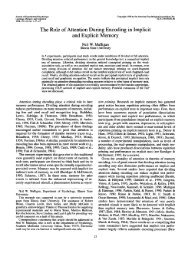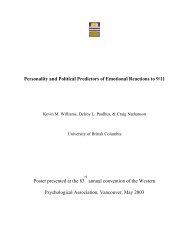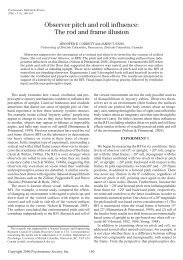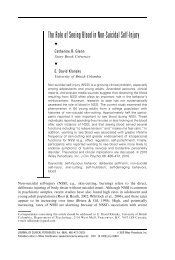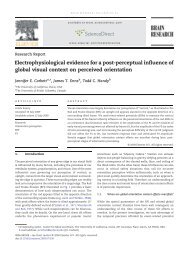Dynamic Social Impact and the Evolution of Social Representations ...
Dynamic Social Impact and the Evolution of Social Representations ...
Dynamic Social Impact and the Evolution of Social Representations ...
You also want an ePaper? Increase the reach of your titles
YUMPU automatically turns print PDFs into web optimized ePapers that Google loves.
Journal <strong>of</strong> Communication, Azitzimn 1996<br />
insights into two <strong>of</strong> <strong>the</strong>ir fundamental <strong>and</strong> underresearched aspects: distribution<br />
<strong>and</strong> content.<br />
Even <strong>the</strong> most pervasive “consensual” stereotypes <strong>of</strong> ethnic groups are endorsed<br />
by something less than 100% <strong>of</strong> people (Katz & Braly, 1933). Stereotypes<br />
<strong>of</strong> any given target group may be similar within particular geographic or social<br />
bounds, but differ importantly across <strong>the</strong> broader canvas <strong>of</strong> social space. Few, if<br />
any, psychological <strong>the</strong>ories <strong>of</strong> stereotypes speak directly to this issue. A preliminary<br />
underst<strong>and</strong>ing <strong>of</strong> <strong>the</strong> distribution <strong>of</strong> stereotypic attitudes can be <strong>of</strong>fered by<br />
<strong>the</strong> processes <strong>of</strong> dynamic social impact. As a result <strong>of</strong> <strong>the</strong> self-organizing dynamics<br />
<strong>of</strong> DSIT, individual knowledge structures that are initially distributed r<strong>and</strong>omly<br />
across a social space become, over time, distributed into clusters that define cultural<br />
knowledge or beliefs (Latane, this issue). DSIT thus <strong>of</strong>fers a very simple set <strong>of</strong><br />
rules through which we can underst<strong>and</strong> why cultural stereotypes are generally, but<br />
not perfectly, consensual <strong>and</strong> how <strong>the</strong>y may differ from region to region.<br />
Ano<strong>the</strong>r fundamental yet largely unexamined facet <strong>of</strong> stereotypes is <strong>the</strong> manner<br />
in which <strong>the</strong>y operate as implicit personality <strong>the</strong>ories (Ashmore, 1981). That<br />
is, stereotypes ascribe multiple attributes to a particular group, <strong>and</strong> those attributes<br />
are <strong>the</strong>mselves perceived to be correlated. A particular ethnic group<br />
might be stereotyped as both unintelligent <strong>and</strong> dirty, for instance. DSIT <strong>of</strong>fers<br />
one explanation as to how two logically dissociated attributes come to be associated<br />
within <strong>the</strong> context <strong>of</strong> <strong>the</strong> cultural stereotype. Over time, two initially unrelated<br />
beliefs that are r<strong>and</strong>omly distributed across social space can become<br />
bundled, or correlated (LatanC, 1996b; Lavine & LatanC, this issue). Thus, DSIT<br />
can account for <strong>the</strong> fact that group stereotypes exist not simply as specific beliefs<br />
about specific group attributes, but as coherent implicit personality <strong>the</strong>ories<br />
shared by large numbers <strong>of</strong> people.<br />
These coherent bundles <strong>of</strong> attributes can be considered to develop lives <strong>of</strong><br />
<strong>the</strong>ir own (Huguet & LatanC, this issue). Although cultural stereotypes are influenced<br />
importantly by <strong>the</strong> aggregate actions <strong>of</strong> populations, <strong>the</strong>ir continued existence<br />
in a culture is not tied in any direct way to <strong>the</strong> specific actions <strong>of</strong> any<br />
single individual. Thus, <strong>the</strong> existence <strong>and</strong> function <strong>of</strong> social representations in a<br />
sociocultural system is not unlike <strong>the</strong> existence <strong>and</strong> function <strong>of</strong> species in a biological<br />
system.<br />
<strong>Social</strong> <strong>Representations</strong> as Species<br />
The attributes <strong>of</strong> a biological species constitute a certain structure that defines<br />
that species as distinct from o<strong>the</strong>rs. The genetic <strong>and</strong> behavioral processes that<br />
determine <strong>the</strong> attributes <strong>of</strong> a species do not operate directly on <strong>the</strong> species itself,<br />
but on its individual members. No species deliberately attempts to evolve<br />
toward any specific set <strong>of</strong> attributes, <strong>and</strong> yet specific sets <strong>of</strong> attributes do indeed<br />
emerge. Just as a biological species is defined by a coherent bundle <strong>of</strong> attributes,<br />
so, too, is a stereotype. Each specific aspect <strong>of</strong> a stereotype (e.g., men<br />
are assertive; pr<strong>of</strong>essors are absentminded) is analogous to a gene. Just as <strong>the</strong><br />
bundles <strong>of</strong> physiological attributes characteristic <strong>of</strong> biological species manifest<br />
66



